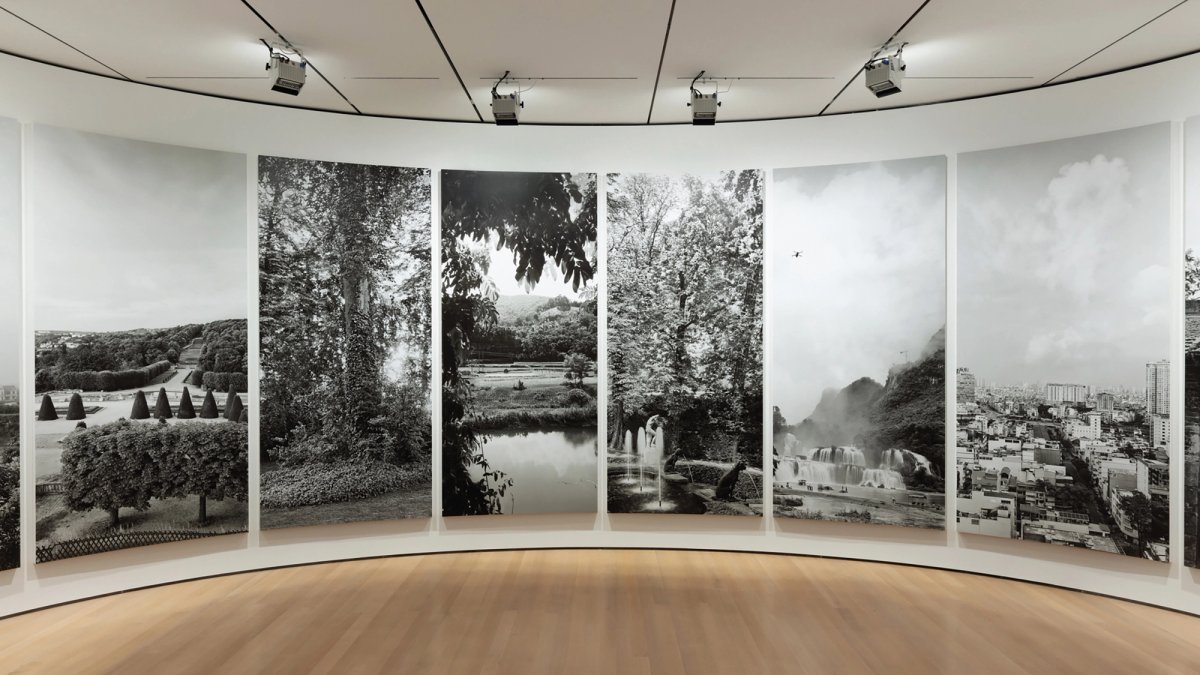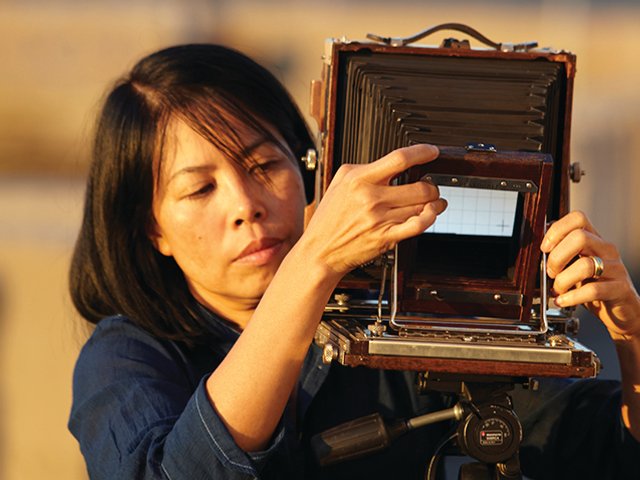In 2021, An-My Lê had an out-of-body experience in the Californian desert. The Vietnamese American artist had been photographing at the Marine Corps Air Ground Combat Center in Twentynine Palms, a landscape she was deeply familiar with from her 29 Palms (2003-04) series showing marines preparing to deploy to Iraq and Afghanistan. Observing the marines’ training exercises once again, Lê was suddenly overcome with grief and transported to her sick mother’s side. She let her mind wander, watching the wind throw up dust and shake the creosote bushes, and recalling how, as a 1970s Vietnamese refugee, her mother’s life—and therefore her own—had been shaped by the very forces she was documenting.
Shifting between the factual and the fragmentary, the deeply personal and the impossibly geopolitical, this anecdote—which Lê recounts in the introduction to her current career survey Between Two Rivers/Giữa hai giòng sông/Entre deux rivières at the Museum of Modern Art (MoMA) in New York—perfectly encapsulates her wider body of work.
I wouldn’t be here, I wouldn’t be a photographer, if it weren’t for the Vietnam War
The MoMA exhibition spans three decades of Lê’s taught, precise photography, from the 1994 series Viet Nam, made on her first trip back to the land of her birth since being airlifted out at 15 in 1975, to the newly completed works such as Someone Else’s War (Gangbang Girl #26) and the site-specific cyclorama Fourteen Views (2023). In between, there are works like the ongoing series, Silent General, a meander through American war re-enactments, the White House set on late-night comedy show Saturday Night Live, felled Confederate statues, Fourth of July celebrations and border patrols along the Rio Grande. With radical poetry and calm, and the eyes of a mother, Lê tackles unbearably complex subjects.
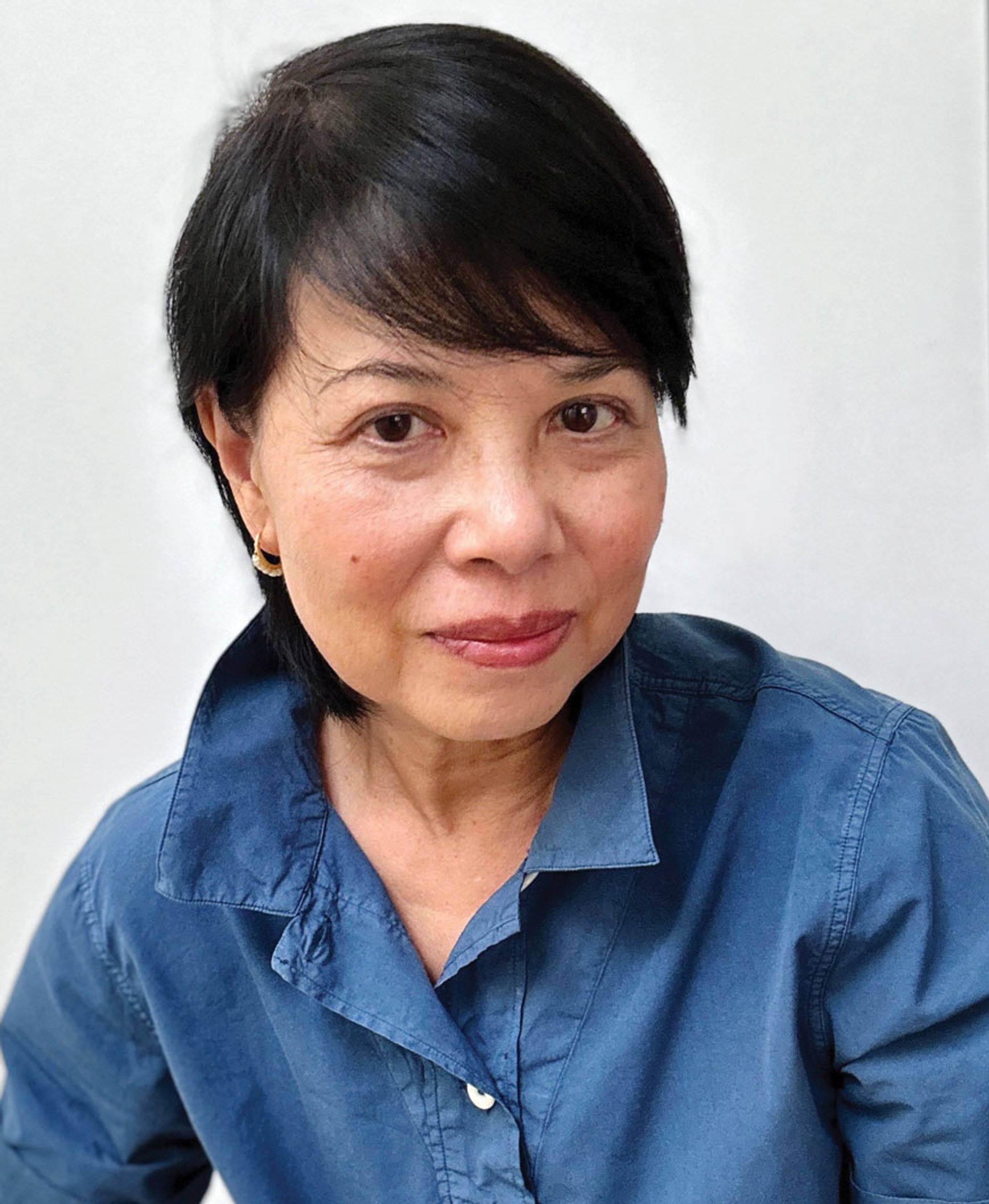
An-My Lê Courtesy of Marian Goodman Gallery
The Art Newspaper: In planning the show, was the titular geographical framing of the two rivers there from the outset?
An-My Lê: The art historian Xueli Wang, who drew up the timeline of my work for the catalogue, came up with the title, referencing the Mekong in Vietnam and the Mississippi in the US but also other rivers like the Seine and the Hudson River. My contribution was to make it trilingual, in Vietnamese, French and English, which instantly lays out the autobiography that runs through my work.
The text you wrote for the catalogue about that out-of-body experience in Twentynine Palms and feeling, as you put it, “utterly unmoored”, is so moving.
I’m really glad you mentioned that essay. I was hoping to drown the reader with very factual, nerdy descriptions of the military exercise I was observing, before describing the spiritual experience I had. It matters to me that my photographs are full of facts. The evidentiary aspect of photography is crucial. [The American photographer] Garry Winogrand once said that there is nothing as mysterious as a fact clearly described. Among my so-called “straight photographer” peers, we speak a lot about why people are often confused about the nature of authorship in our work. We know that Thomas Demand is an artist who uses photography, because he’s constructing the sets and objects that he then photographs. Cindy Sherman uses herself to construct characters and performs for the camera. Working in the real world makes it more difficult to respond to that question of where the art is. I see the world as full of building blocks that I use to construct an image that might help me express myself.
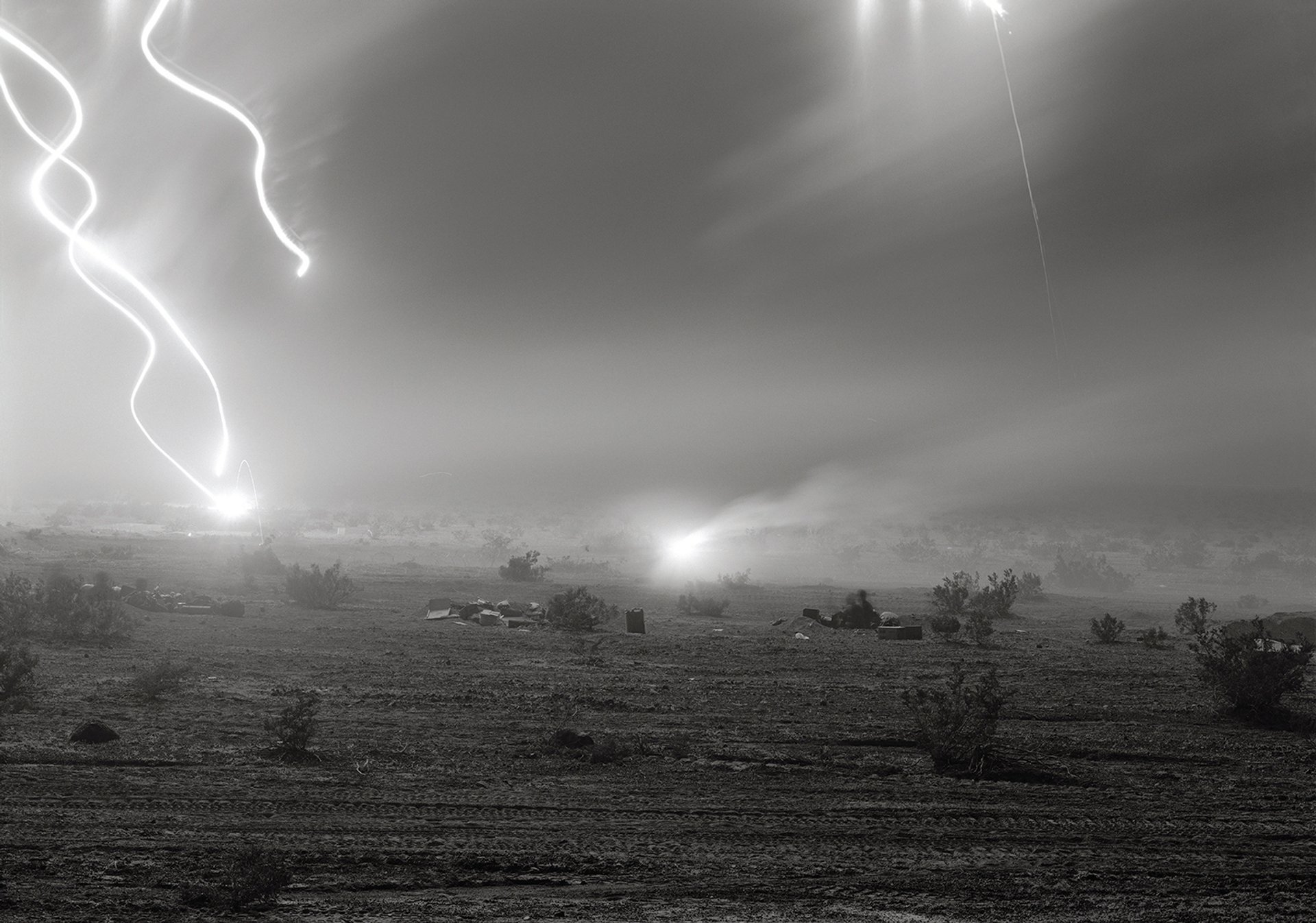
Night Operations IV, from the series 29 Palms (2003-04), shows American marines at a Californian combat centre achieving battle-readiness in advance of deployment to overseas war zones © An-My Lê, courtesy of the artist and Marian Goodman Gallery
How did that out-of-body experience lead to the show’s newest work, Fourteen Views?
Positioned on that hill in Twentynine Palms, 75ft above the training ground on the canyon floor, I was observing an exercise happening in all directions: helicopters swooping in from my right, howitzers firing far in the distance at enemy targets, convoys of armoured vehicles rolling in on my left. It was very confusing—an experience that, I realised, could only be processed as a 360-degree experience. At first, I imagined making a circular immersive viewing experience, with high-resolution digital images stitched together seamlessly. But the vertical landscapes of Robert Adams, in his 1994 book, Listening to the River, suggested a new direction. I thought about similarly discrete panels, that could work together, united by horizon lines, repeated forms, connecting shapes, textures and tonal range.
The resulting 14 vertical landscapes arranged in an elliptical cyclorama function as a kind of fluvial journey. It starts out by boat in Vietnam and ends in the swamp of the bayous in Louisiana. It takes in the Bản Giốc waterfalls at the Vietnamese-Chinese border and the Red River and the Mekong as well as the garden fountains of the Château de Saint-Cloud in Paris, where the photographer Eugène Atget worked in the early 1900s. There are many conceptual through lines that tie the panels to one another. The yellowwood (Cladrastis lutea), photographed in the Domaine national de Saint-Cloud, is a north American variety brought over to France from a plantation in the American South. Fourteen Views deconstructs the format’s 19th-century imperial origin, sketching out the intertwined histories of colonisation and geopolitics between Vietnam, France and the US.
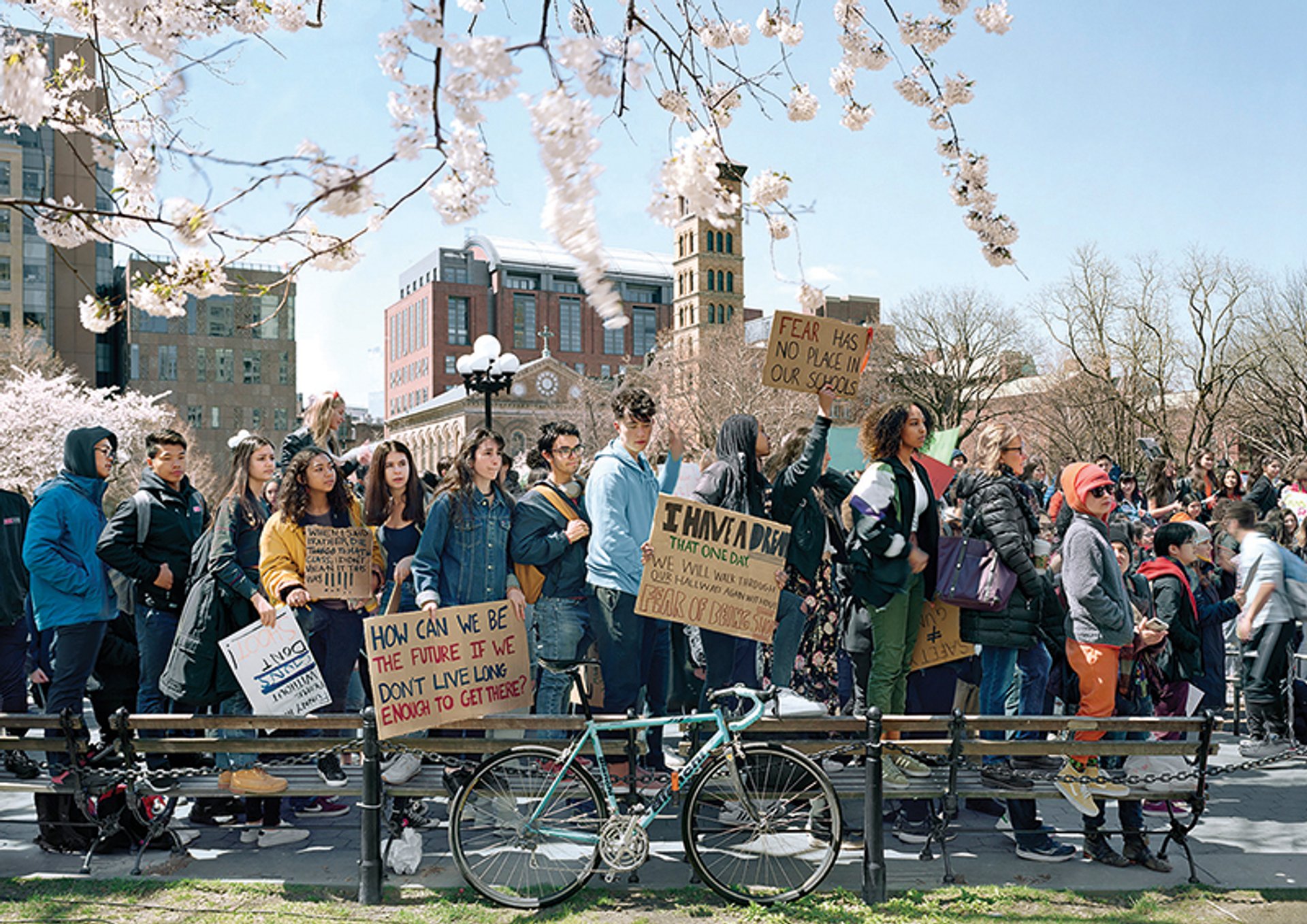
High School Students Protesting Gun Violence, New York City, from the ongoing series Silent General © An-My Lê, courtesy of the artist
The MoMA director Glenn Lowry has said of this show that it is an “invitation to see the world through a more complicated lens”. How do you navigate complexity?
Even before working on Fourteen Views, I had been thinking about how to go beyond the single image. Silent General is made up of what I’ve called “fragments”, smaller groupings of five to seven images, a structure inspired by Walt Whitman’s 1882 collection of prose, Specimen Days & Collect. In a suite of photographs, you may pay attention to the space between the pictures as you go from picture to picture. It’s a kind of silence, in which you hold the memory of what you have just seen but also reinterpret it, before moving on to the next image. Silent General has explored America in all its divisions since 2015. It’s about not simplifying or reducing the issues we are confronted with today, but about bringing together conflicting ideas and keeping people engaged and wanting to think.
How did Someone Else’s War (Gangbang Girl #26) come about?
Putting this show together I was reminded of how many projects find their beginnings in questions raised by previous projects. After publishing Small Wars in 2006, someone asked if I thought I might be fetishising the military in my work. It could have been taken as a passive-aggressive comment, but I was intrigued by the suggestion of aesthetic danger.
While doing research on war re-enactments in 2000, I had found a pornographic film that features American men playing US GIs, and two Asian (though not Vietnamese) women playing Vietnamese sex workers. It was ideal source material with which to tackle the mythologising of war and racialised sexuality, subjects I’m still not sure I’d ever be able to address with straightforward photographs.
I spent a lot of time figuring out how to transform the video stills. Watercolour proved too subtle a medium and technically difficult to grasp but embroidery allowed me to break down the image and somewhat control it. Of course, it is also a great Vietnamese tradition. I had learned to embroider in middle school in Paris, but my assistant and I did further training with professional seamstresses in Vietnam. Choosing which images to embroider was crucial. I was not so interested in the classic hardcore porn images. I was more influenced by Goya’s unflinching depiction of the carnage of war and destruction, in his Disasters of War print series.
It’s been laborious but the content demanded a slowing down. It’s the antithesis of the rapid, gluttonous consumption of porn. I also love how, in the exhibition, these embroideries are dropped into the Pompeian time capsule [section] and connect with my works on the erotic frescoes. Such imagery was acceptable, even in the context of family life, at the time. But many of these Roman sex workers were slaves or war prisoners. Here too, you see the idea of violence perpetuated against women in an imperial, colonial context.
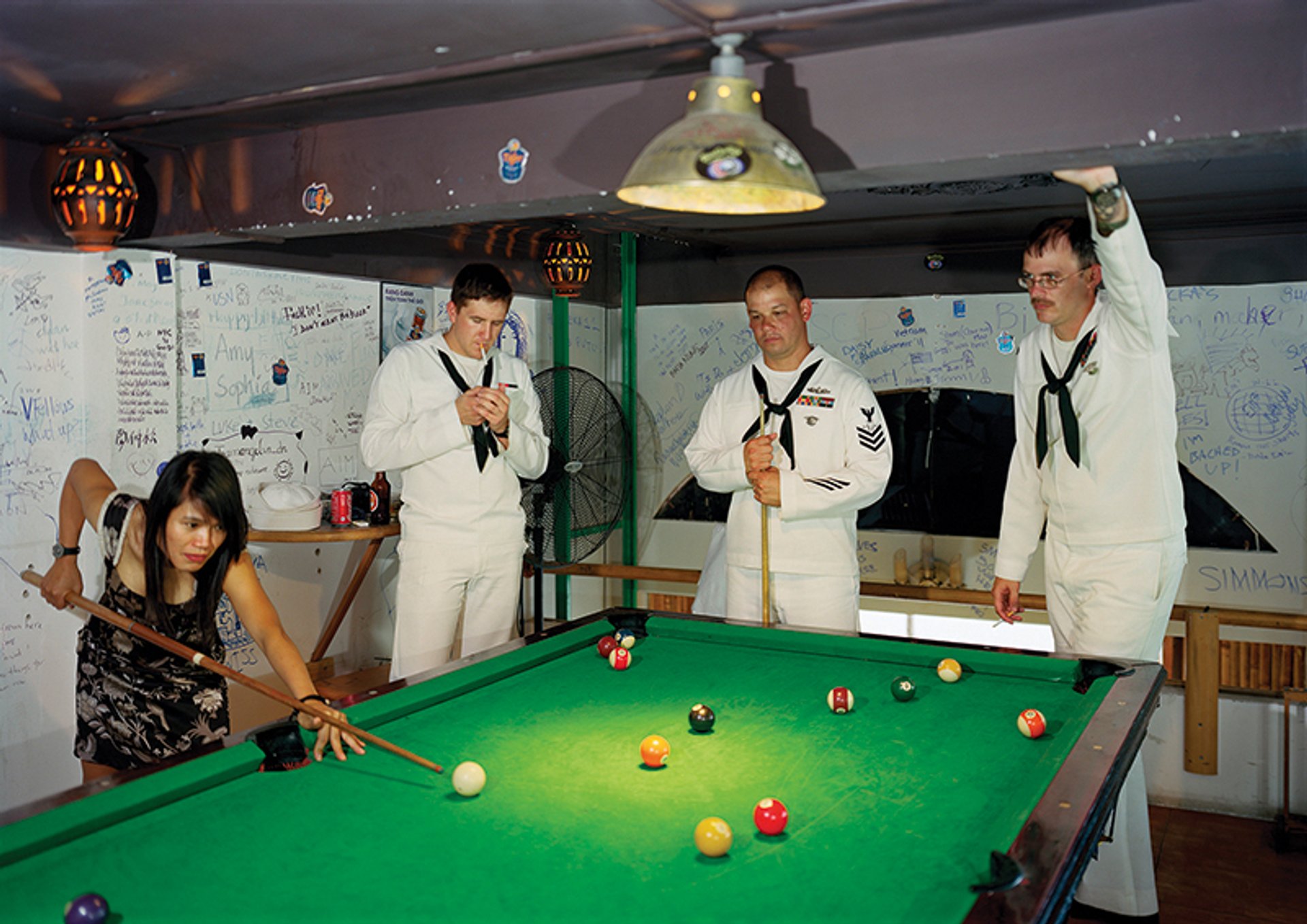
Sailors on Liberty from USS Preble, Bamboo 2 Bar, Da Nang, Vietnam, from the 2006 series Events Ashore © An-My Lê, courtesy of the artist and Marian Goodman Gallery
Even a piece as complex and difficult as Someone Else’s War features—as the senior curator Roxana Marcoci points out—small acts of resistance and female solidarity. Have you consciously focused on the female gaze in your work?
It’s not something that I have looked for: it’s what I have responded to. I’ve always admired the psychological portraiture [that] August Sander, Judith Joy Ross and Rineke Dijkstra achieve, but found it difficult to do myself. But for the 2006 Events Ashore series, I worked at sea, on US Navy battleships, aircraft carriers and submarines. The portraits I did of women there worked, I think, because I was interested in how they were carving out their own spaces within a male world. They were as competent as the men. Some, like the woman in the brown shirt with the helmet and the oil under her fingernails, wanted to be like the guys. Others plucked their eyebrows and found flattering fitted green shirts.
Students confusedly think that making work about identity means talking about their families or about who they are. The poets Ocean Vuong and Monique Truong—who both contributed to the catalogue—and I have spoken about how identity is not necessarily about telling your story. Rather, it helps you figure out how to work or where to go.
Thinking about my mother’s life in a place where the American military is training, you see the broad strokes of history, of colonial forces and American geopolitics, but then you see the impact they’ve had on someone’s life—for good and for bad. I wouldn’t be here, I wouldn’t be a photographer, if it weren’t for the Vietnam War. It’s destiny. And it’s devastating. There’s a sense of helplessness in the face of these incredible forces, but there is also individual agency.
• An-My Lê: Between Two Rivers/Giữa hai giòng sông/Entre deux rivières, Museum of Modern Art, New York, until 16 March 2024


